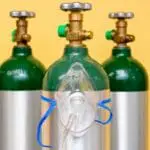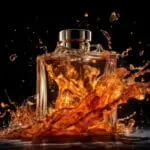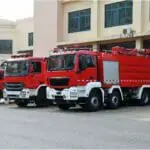If you’ve ever seen a firefighter at a scene, you might have noticed that they carry air tanks to breathe from in low-oxygen conditions.
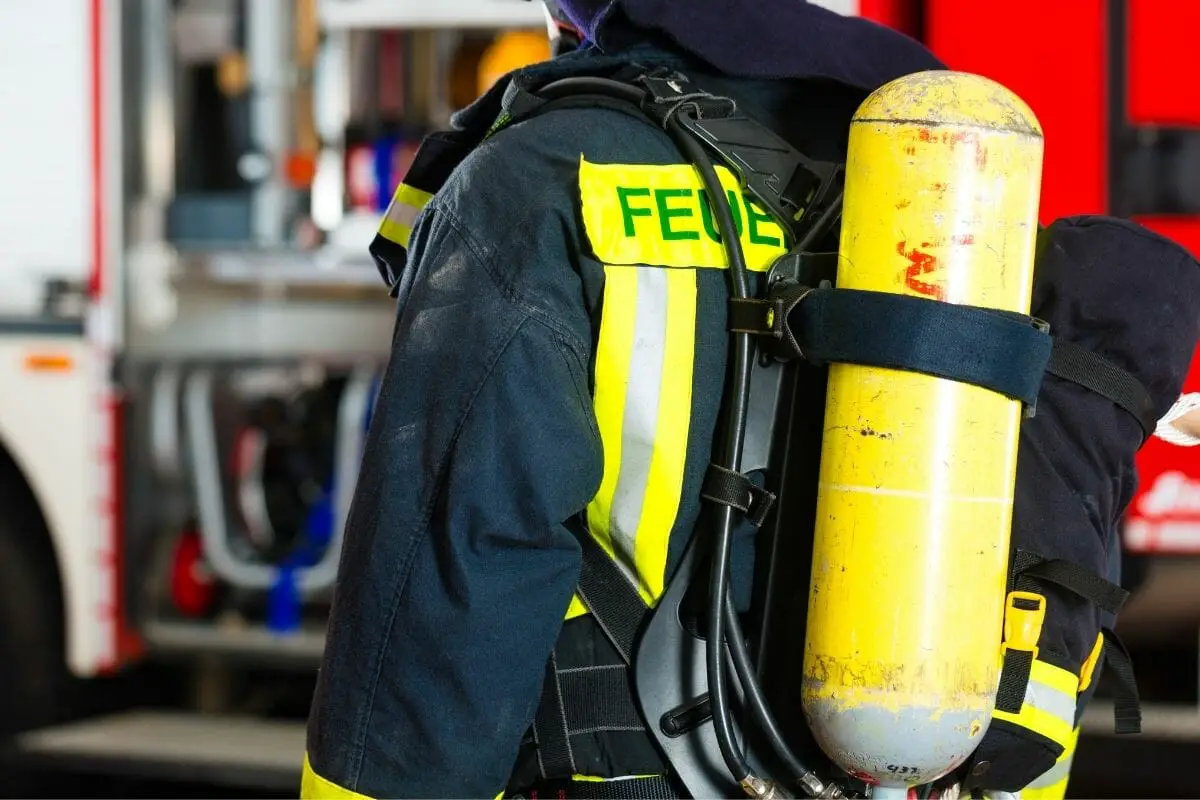
But how is this possible in the first place? Wouldn’t the oxygen tank blow up on contact with flames?
Firefighters use a type of air tank that’s known as Self-Contained Breathing Apparatus. These won’t detonate in heat as they use compressed air, not oxygen.
The tanks are also equipped with burst disks that stop the tank from rupturing under intense pressure.
We’ll cover more about Self Contained Breathing Apparatus tanks below, and why these won’t explode in extreme heat conditions, even though the air in our atmosphere is full of oxygen.
Can Oxygen Catch Fire?
Most people have seen an oxygen tank bursting into huge flames on the big screen, but would this happen in real life? Can oxygen catch fire?
Oxygen can make a fire worse, but the element isn’t flammable. Producing fire and keeping it burning requires three elements, fuel, heat, and oxygen.
If oxygen isn’t used, another type of oxidizer will also do.
Flammable gases, such as methane, are suitable fuel sources, but they would still require a decent amount of heat and oxygen to continue burning.
Oxygen isn’t flammable, so a fire can only be created if it’s exposed to heat and fuel.
Don’t take this to mean that oxygen cannot produce explosions. If a fire is already in place, oxygen can make the fire worse.
The gas can make the flames more severe, which could lead to an explosion later.
This same explosive impact can occur with other oxidizing chemicals, like bromine or hydrogen peroxide.
Even though oxygen isn’t flammable, the utmost care needs to be taken when handling fire and oxygen, as there’s a risk of making a fire worse.
This explains why a firefighter’s tank shouldn’t contain pure oxygen in it. The oxygen would be sealed inside the tank, but leaks are always a possibility.
The seal on a face mask could fail and leak any gases out into the fiery environment.
If a leak occurred, the flames that the firefighters were attempting to extinguish could become worse. This makes an already unsafe situation even more perilous.
A firefighter's air tank may not contain pure oxygen, but their face masks always need to be sealed well.
Other than the risk of leaks, the seal will stop any chemicals, hot air, and smoke from entering the firefighter's lungs.
This is one reason why beards aren’t permitted in the fire service, as facial hair can affect the mask’s seal on the person’s face.
More About The Self Contained Breathing Apparatus
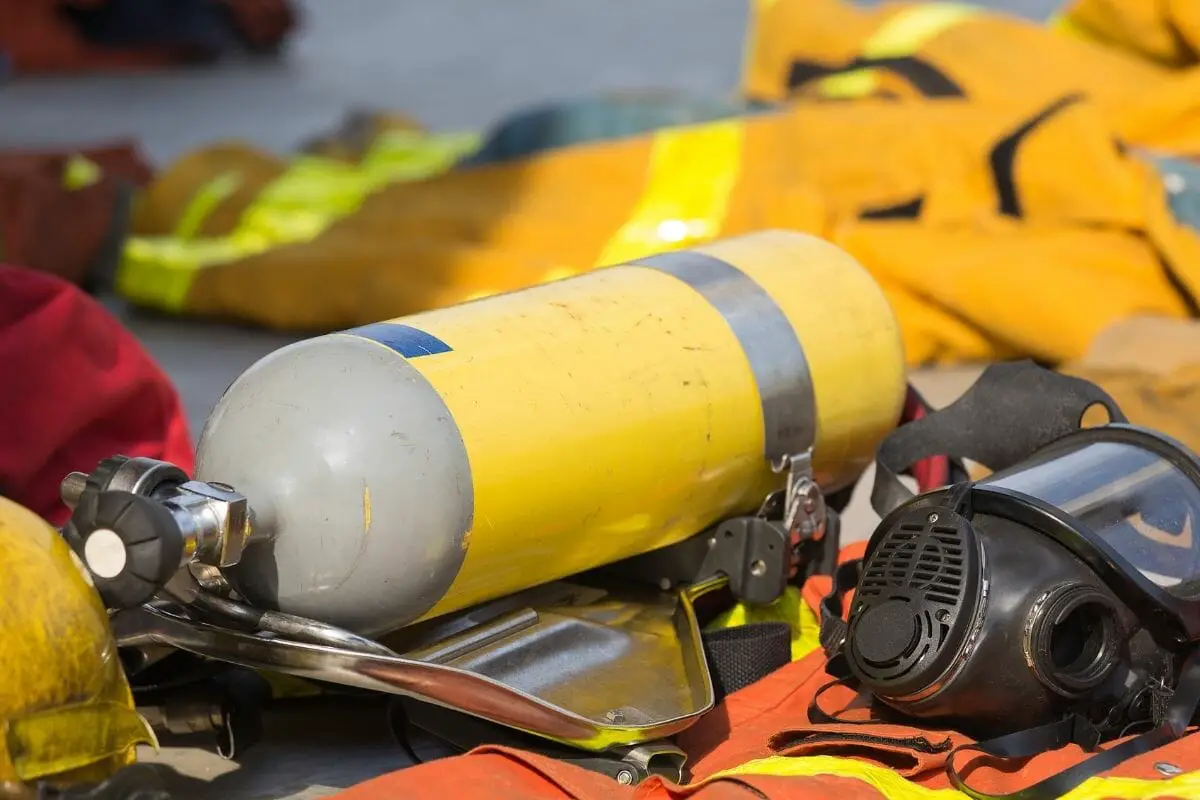
Also known as SCBA’s, these tanks are one of the most essential components of a firefighter's safety equipment.
The air tanks look like SCUBA tanks that let divers breathe underwater, but the difference is that SCBAs let firefighters breathe clean air in smoky, fiery conditions.
Smoke and heat from a fire are dangerous for the skin, but a firefighter’s respiratory organs can experience much more damage from smoke, chemicals, and intense hot air.
Smoke from fires has always been dangerous, but thanks to updates in technology, it's become even more unsafe in the modern world.
There are so many appliances and items made from synthetic plastics which release dangerous chemicals when heated.
Examples include carbon monoxide, arsenic, and hydrogen cyanide, to name a few.
If the toxic smoke from a fire reaches the lungs, this can result in serious health issues and in the worst case, death.
A Self Contained Breathing Apparatus looks like an air tank that’s integrated into a harness worn on the back.
It’s made from an aluminum/carbon composite and is equipped with important pressure controllers.
These regulators lower the amount of pressure that the tank undergoes, changing it to an optimum pressure so a firefighter can breathe.
The pressure-adjusting hose is linked to a complete face mask that shields the face, throat, lungs, and mouth from harm.
The majority of SCBAs use positive pressure. If a firefighter breathes in from the tank, the pressure lowers and tells the necessary valve to open and let air into the mask.
The valve only opens when the firefighter breathes, which helps to avoid air leaks.
SCBAs tend to have a display so the firefighter can keep an eye on how much remaining air they have left.
This is usually attached to a strap or a computer in the mask. The tanks will also use a Personal Alert Safety System.
If a firefighter doesn’t move for a specific amount of time, the PASS will sound an alarm. This lets the fallen firefighter’s crew find them and provide any required assistance.
Can Compressed Air Tanks Explode?
We’ve covered why a SCBA doesn’t contain pure oxygen. However, as regular air is full of oxygen, does this mean the tank may still catch fire?
The air that we breathe every day contains 20.9% oxygen, which is enough for humans to breathe. This percentage of oxygen is the same amount that’s in the SCBA.
Oxygen inside an air pack won’t affect a fire’s intensity any more than the current air around a burning building.
Despite this, there is a potential scenario in which an air tank may rupture and catch fire.
The compressed air inside the tank will shrink or expand depending on the surrounding temperature.
If this temperature is hot enough, say in a particularly intense fire, the pressure within the SCBA may continue to grow.
If this is left unchecked, the tank may split and become particularly dangerous.
This sounds frightening, but businesses that produce air tanks are well aware of this problem. They equip their tanks with safety elements that reduce the chance of this occurring.
Many SCBAs are tested to stand up to a minimum of 6000 psi. They are also built with a safety valve that releases excess pressure and stops the tank from breaking.
This drastically lowers the chance of the air tank catching fire.
Conclusion
Air tanks, or SCBAs, do contain oxygen, but oxygen isn’t a flammable gas. Creating fire requires fuel, heat, and an oxidizer to continue burning.
Oxygen may make a fire worse, but a SCBA only contains around 20% oxygen, which is the same amount as the air we breathe.
So an air tank won’t be at risk in a fire any more than the air around the firefighter.

